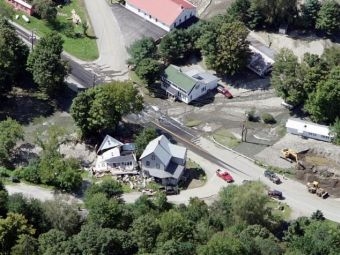Coping After Irene

(Host) A number of Vermont communities were cut off from the rest of the state in the wake of Tropical Storm Irene.
At this point, all have been reconnected to the outside world to varying degrees.
VPR’s Steve Zind has this look at how one of those towns dealt with the challenge of going it alone in the immediate aftermath of the flooding.
(Zind) Even in normal times, the 1100 or so residents of the Central Vermont town of Rochester live in relative isolation. The village is wedged between the mountains along a branch of the White River on Route 100.
When Irene washed out the roads into town, along with the power lines and all phone service, Rochester residents – like those in other cut off villages and back roads neighborhoods, calmly took charge.
(Man) “I was wondering if the medications came in?”
(Woman) “Yes, the meds pickup is right here…”
Once it was determined no one had been injured and everyone was safe – a top priority became taking care of people who need prescription medicine. Doon Hinderykx is a Rochester selectman.
Henderykx says cell phone calls were made from the top of a nearby mountain to the hospital in Randolph which sent out badly needed prescription medicine on ATV’s. On Monday the first shipment rendezvoused with a group from Rochester who rode down the washed out mountain road on bicycles to meet them.
(Hinderykx) “And this young girl, Clair, was on the first bicycle expedition to get the medications over on Camp Brook Road. It was a little more rugged than you thought it would be, wasn’t it?
(Clair) “Definitely”
(Zind) How old are you, Clair?”
(Clair) “Fourteen.”
(Zind) Hinderykx says food has never been a problem. The local chain supermarket gave away all its perishable stock.
For those who can’t cook a local café is providing free breakfast, the elementary school is serving lunch.
(Man) “All that up there is organic chicken that people brought in and donated…”
(Zind) And every night there’s a free dinner served on the lawn of the Huntington Inn in the center of the village. Scott Holtz, the inn’s co-owner says the menu is made up of food people bring in from their slowly defrosting freezers.
(Holtz) “They’re kind of watching their freezers and they bring it down to us and we cook it up and then at about 5 o’clock every night we open up the gates and everybody comes and dines (laughs).
(Zind) “What’s the turnout been like?”
(Holtz) “Phenomenal. Hundreds every night!”
(Zind) There’s been plenty of outside offers of food, too. Wednesday afternoon a pair of hikers arrived with backpacks full of batteries, baby formula and Spam.
For the people living outside the village getting resupplied with food, fuel and other necessities has been a bigger challenge.
(Woman) “It’s kind of scary.”
(Man) “It don’t scare me so much, I can swim. It’s old age!”
(Zind) South of the village, Route 73, which once crossed the river, now ends in it. On Tuesday, a local mason built a cleverly constructed footbridge and by Wednesday afternoon, a steady line of people moved across it carrying goods for those who live on the other side.
John Lambert was there helping his mother in law Pam Gendron.
(Zind) How hard has it been until this bridge has been put in to get what you needed.
(Gendron) Well, we didn’t get much of anything. We had everything we needed already.
(Zind) “Is anybody else in any trouble of any sort up there?”
(Lambert) “I actually just took the EMT squad and the police officer around door to door to different people to find out if anybody needed anything. Most people are pretty much all set out here. The only thing that we kind of miss is being able to get over there.”
(Zind) For some in Rochester the flood represents much more than a temporary hardship or inconvenience. Several houses are considered total losses. One lies in the river, tilted back and split open. It belongs to Beth Frock and Jon Graham and their two children.
For the moment the family is staying with Graham’s employer in town. Frock says the future is uncertain.
(Frock) “We don’t know. We don’t know what we’re going to do. We can’t build our house there because it took away half our property that got eroded away. So we don’t know.”
(Zind) Each day more vehicles have been making it through to the once cut-off village.
Sheila Braun of Burlington found her way here in her pickup truck. Since there was no mail, no phone, no internet and no cell service for people to contact loved ones in town, she posted a Facebook message saying she was willing to deliver messages to them.
(Braun) “There was just such heartache in these messages. One guy is worried about his family who are buried in the cemetery.”
(Zind) Woodlawn Cemetery suffered significant erosion damage, dislodging and damaging a large number of caskets. State and federal officials have taken over the task of identifying and re-interring the remains.
And despite the success of dealing with the immediate problems posed by the flooding, town health officer John White says there are other longer term issues to confront.
(White) “Now we’re starting to get problems with people worrying about fuel oil in their basements, the basement’s flooded, and things like that.”
(Zind) Town officials say once services are up and running again, local businesses are going to need support, too.
And those services are beginning to come back. Late on Wednesday some land line phone service was restored. One resident told a town official that shortly after his phone started working again he received his first call: From a telemarketer.
For VPR news, I’m Steve Zind.